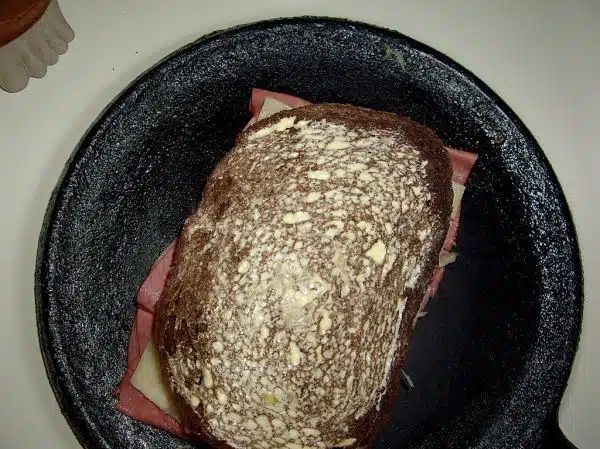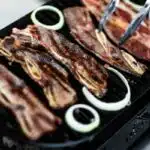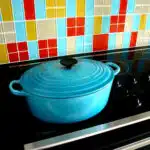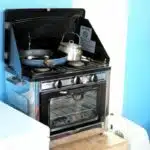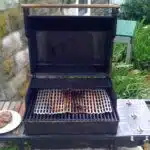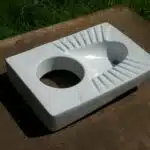Cast iron griddles have been used for centuries, and they remain one of the most popular kitchen utensils due to their durability and versatility. However, over time, these griddles tend to build up residue, which can affect the quality of food cooked on them. Proper cleaning of a cast iron griddle is therefore crucial to maintaining its effectiveness in cooking food.
As a cast iron cleaning expert, I understand the importance of keeping these kitchen utensils clean and well-maintained. Cleaning a cast iron griddle may seem like a daunting task, but with the right tools and knowledge, it can be done easily and efficiently. In this article, I will provide you with tips and tricks on how to clean your cast iron griddle effectively so that you can enjoy delicious meals cooked on it for many years to come.
Understanding Your Cast Iron Griddle
Cast iron griddles are a versatile and durable cooking tool that requires proper maintenance to maintain its longevity. Understanding seasoning is crucial in ensuring your cast iron griddle stays in good condition. Seasoning refers to the process of coating the griddle with a layer of oil, which creates a non-stick surface and prevents rust from forming. A well-seasoned cast iron griddle will enable you to cook food without sticking while also adding flavor to your dishes.
Proper maintenance techniques for cast iron griddles include cleaning and storing them correctly. Cleaning should be done after each use using warm water and mild soap. Avoid using abrasive materials such as steel wool or metal utensils that can scratch the surface and damage the seasoning layer. Once cleaned, dry the griddle thoroughly with a cloth before storing it in a cool and dry place.
Before proceeding with cleaning your cast iron griddle, it’s essential to follow some safety precautions. Always wear protective gloves as the griddle may become hot during cooking, and never use harsh chemicals that can harm you or damage the surface of your cast iron griddle. Following these safety measures will ensure that you clean your cast iron safely while extending its lifespan.
Safety Precautions Before Cleaning
Picture this: you’re about to clean your cast iron griddle, and you’re excited to make it look like new again. However, before diving into the cleaning process, it is essential to take safety precautions seriously. Using protective gear and ensuring proper ventilation are vital steps that must be taken before beginning any cleaning task.
Firstly, using protective gear such as gloves and goggles is crucial when dealing with harsh chemicals or hot surfaces. It helps protect against burns, cuts, and other potential hazards that may occur during the cleaning process. Additionally, protective gear provides an extra layer of protection against harmful chemicals that may cause respiratory problems if inhaled.
Secondly, proper ventilation is critical when cleaning a cast iron griddle. The fumes produced by the cleaning agents can be harmful if inhaled over a prolonged period. Therefore, it’s best to clean your griddle in a well-ventilated area or use a fan to improve air circulation while cleaning.
Lastly, following safety precautions before starting the actual cleaning process can prevent accidents or injuries from occurring. By taking these measures seriously, you can ensure a safe and successful cleaning experience.
Now that we’ve discussed the importance of taking safety precautions let’s move on to the next step: preparing your cast iron griddle for cleaning.
Preparing Your Cast Iron Griddle For Cleaning
Before cleaning your cast iron griddle, it is important to prepare it properly. This will ensure that the griddle is clean and ready for use the next time you need it. One important step in preparing your cast iron griddle is to make sure that it is well-seasoned. Seasoning techniques vary among experts, but generally involve applying a thin layer of oil or fat to the surface of the griddle and heating it in an oven or on a stovetop until it becomes hot.
Common mistakes that people make when preparing their cast iron griddles for cleaning include using harsh chemicals or abrasive scrubbers. These can damage the surface of the griddle and remove its seasoning, which can make it more difficult to cook on in the future. To avoid these mistakes, use only mild soap and warm water to clean your cast iron griddle, and avoid using any kind of scouring pad or metal brush.
Once you have prepared your cast iron griddle properly, you can move on to cleaning it. The next section will discuss how to remove residue with salt and oil, which is a simple and effective way to clean your cast iron griddle without damaging its surface or removing its seasoning. By following these steps carefully, you can keep your cast iron griddle looking great and functioning perfectly for years to come.
Removing Residue With Salt And Oil
Did you know that about 30% of Americans own a cast iron pan? Cast iron is a popular choice for cooking due to its durability and non-stick qualities when properly seasoned. However, cleaning a cast iron griddle can be challenging, especially when it comes to removing burnt-on food residue.
Using heat treatment is an effective way to remove stubborn burnt-on food from your cast iron griddle. Here are some steps to follow:
- Preheat your oven to 400°F.
- Place the cast iron griddle upside down in the oven on the top rack.
- Bake for one hour and let it cool completely before handling.
Another option for removing burnt-on food residue is using salt and oil. Here are some steps to follow:
- Pour a generous amount of coarse kosher salt onto the griddle.
- Add a small amount of vegetable oil.
- Use a scrubber or brush to scrub away any stuck-on food particles.
By using these techniques, you can restore your cast iron griddle back to its original condition. In the next section, we will discuss how to use vinegar and baking soda as an alternative cleaning method without damaging the seasoning of your cast iron griddle.
Using Vinegar And Baking Soda To Clean
After removing residue with salt and oil, using vinegar and baking soda is another effective method to clean a cast iron griddle. Vinegar is an acid that breaks down stubborn residual grease and food particles, while baking soda acts as a mild abrasive that helps remove any stuck-on debris. This powerful duo can help restore your cast iron griddle to its original state.
One of the benefits of using vinegar and baking soda is their affordability. Both items are readily available at any grocery store and are significantly cheaper than commercial cleaning products. Additionally, they are eco-friendly, non-toxic, and safe for use around food surfaces. However, there are some drawbacks to consider when using these ingredients. The acidic nature of vinegar can strip away the seasoning on your cast iron griddle if left on for too long. Baking soda can also cause scratches if used excessively or with a harsh scrubbing tool.
If you prefer alternative cleaning methods, there are various options available in the market such as specialized cast iron griddle cleaners or electric scrubbers. However, it’s important to note that not all cleaning methods may be suitable for your specific cast iron griddle model or type of residue buildup. It’s always best to consult your manufacturer’s guidelines before trying out any new cleaning method to avoid damaging your cookware.
When it comes to scrubbing with a chain mail scrubber, this method is highly effective in removing stuck-on debris without scratching the surface of your cast iron griddle. This type of scrubber is made from interlocking stainless steel rings that gently scrape away any residual grease or food particles without causing damage to the surface. However, it’s essential to use caution when using this tool as it can still potentially strip away seasoning if used too vigorously or excessively.
Scrubbing With A Chain Mail Scrubber
A chain mail scrubber is a useful tool for scrubbing your cast iron griddle. Made from interlocking stainless steel rings, the scrubber does not scratch or damage the surface of the griddle. Instead, it removes any food debris or residue without leaving any scratches or marks on the surface.
One of the benefits of using a chain mail scrubber is that it is durable and long-lasting. Unlike other types of scrubbers, such as sponges or brushes, which can wear out quickly with regular use, chain mail scrubbers can last for years with proper care. They are also easy to clean and sanitize, making them a hygienic option for cleaning your griddle.
While there are alternatives to using a chain mail scrubber, such as using kosher salt or baking soda to scrub your griddle, these methods may not be as effective at removing stubborn food debris. Additionally, they may leave behind a residue that needs to be rinsed thoroughly. With a chain mail scrubber, you can easily remove any food debris without leaving behind any residue or requiring excessive rinsing.
Transition: Now that you have learned about the benefits of using a chain mail scrubber, let’s move on to another method for cleaning your cast iron griddle – using soap.
Using Soap To Clean Your Griddle
Using soap to clean your cast iron griddle is a common approach, but it comes with its own set of pros and cons. One of the advantages of using soap is that it’s effective in removing stubborn stains and food debris that may have built up over time. This method also ensures that your griddle remains hygienic by killing bacteria and germs.
However, using soap can be detrimental to your cast iron griddle if not done correctly. It can strip away the seasoning that has been built up on the surface of your griddle over time, leading to rusting and corrosion. Additionally, if you use too much water while cleaning with soap, this can lead to water spots forming on your griddle.
There are alternatives to using soap when cleaning your cast iron griddle that are equally effective without damaging your equipment. For instance, you could use baking soda mixed with water to create a paste-like consistency. This mixture works well as a gentle abrasive that won’t damage the surface of your griddle. You could also try using vinegar or lemon juice instead of soap as these acidic substances help cut through grease and oil without harming the seasoning on your griddle.
To ensure that you don’t damage your cast iron griddle while cleaning it with soap or any other method, it’s essential to follow proper cleaning procedures carefully. In the next section, we will discuss how you can rinse and dry your griddle thoroughly after cleaning it to prevent rusting or corrosion from occurring.
Rinse And Dry Your Griddle Thoroughly
Now that you have washed your cast iron griddle, the next step is to dry it thoroughly. Proper drying is crucial to prevent rust and extend the lifespan of your cookware. There are two methods you can use to dry your cast iron griddle: air drying and towel drying.
Air drying is the preferred method for drying a cast iron griddle because it allows for natural evaporation without leaving any moisture behind. To air dry your griddle, simply place it upside down on a wire rack or in a warm, dry place for several hours until all moisture has evaporated. This method ensures that no excess water remains on the surface of the griddle, which could cause rusting.
On the other hand, towel drying can be used if you need to use your cast iron griddle immediately after cleaning. However, this method requires extra care as it can leave small fibers behind on the surface of the griddle which may affect the seasoning process. If you choose to towel dry your cast iron griddle, make sure to use a clean, lint-free cloth and wipe gently in a back-and-forth motion until all moisture has been removed.
Now that you know how to properly dry your cast iron griddle, it’s time to move on to re-seasoning. But before we do that, let’s take a moment to discuss why proper drying is so important. By ensuring that your cast iron griddle is completely dry after washing, you are preventing rust from forming and extending its lifespan. So take care when drying and always choose air-drying over towel-drying if possible!
Re-Seasoning Your Cast Iron Griddle
- Rust can be removed by scrubbing the cast iron griddle with steel wool, coarse salt, and a small amount of oil.
- To season the cast iron griddle, it should be wiped with a thin coat of oil.
- Heating the griddle on a hot stovetop after applying oil can help seal in the seasoning.
- It is also important to ensure that the oil is heated to its smoke point to avoid creating a sticky residue on the griddle.
- After re-seasoning the cast iron griddle, the excess oil should be wiped away with a paper towel or a clean cloth.
- Regularly re-seasoning a cast iron griddle will help maintain its nonstick properties and prevent it from rusting.
Removing Rust
Removing rust from your cast iron griddle is crucial in maintaining its quality and prolonging its lifespan. Rust can cause corrosion to the metal, which can lead to damage or even render the griddle unusable. To prevent this, it is important to know how to remove rust properly.
First, start by scrubbing the affected area with a stiff brush or steel wool pad. This will help remove any loose rust particles on the surface of the griddle. Next, create a paste using equal parts vinegar and baking soda. Apply this paste onto the rusty areas and let it sit for at least 30 minutes. Afterward, rinse off the paste with warm water and dry thoroughly.
To prevent further rust from forming, make sure to always clean and dry your cast iron griddle after each use. Applying a thin layer of oil or grease can also help prevent moisture from building up on the surface of the griddle. By following these steps, you can ensure that your cast iron griddle stays rust-free and in top condition for years to come.
Remember that maintaining your cast iron griddle is a responsibility that comes with owning one. It may take some extra effort, but it’s worth it in the end when you’re able to enjoy perfectly cooked meals every time. With proper care and attention, your cast iron griddle will last for generations to come!
Applying Oil
As a cast iron cleaning expert, I highly recommend applying oil to your cast iron griddle as part of the re-seasoning process. This step is essential in preventing rust and ensuring that your griddle maintains its non-stick surface. Applying oil also helps to create a protective barrier that keeps moisture at bay.
When it comes to choosing the best oils to use on your cast iron griddle, there are several options available. Some of the most popular choices include vegetable oil, canola oil, and flaxseed oil. These oils work well because they have high smoke points, which means they can withstand high temperatures without breaking down or burning. It’s important to note that you should avoid using olive oil or butter as they have low smoke points and will not provide adequate protection for your griddle.
To ensure that your cast iron griddle stays in top condition, it’s important to apply oil regularly. How often you need to apply oil depends on how frequently you use your griddle. If you use it daily or weekly, then you should consider applying a thin layer of oil after each use. If you only use your griddle occasionally, then you may only need to apply oil once every few months.
In summary, applying oil is an essential step in re-seasoning your cast iron griddle. By choosing the right oils and applying them regularly, you can prevent rust and maintain your griddle’s non-stick surface for years to come. Remember that proper care and attention are crucial in ensuring that your cast iron griddle lasts for generations!
Heating To Seal
Now that we’ve discussed the importance of applying oil to your cast iron griddle, let’s move on to the next step in re-seasoning: heating to seal. Heating your griddle after applying oil not only helps to create a non-stick surface but also seals in the oil and prevents it from becoming rancid. The benefits of heating extend beyond sealing in oil; it also helps to eliminate any moisture that may have been left behind during cleaning.
To heat your cast iron griddle, preheat your oven to 350 degrees Fahrenheit or use a stovetop burner set to medium-high heat. Once heated, place your griddle upside down on the middle rack of the oven or directly on the stovetop burner for 20-30 minutes. This will allow the oil to penetrate into the pores of the iron and create a smooth, non-stick surface. It’s important not to overheat your griddle as this can cause damage and even warp it.
While heating is an effective way to seal in oil, there are alternative sealing methods such as using beeswax or flaxseed oil paste. However, these methods require more effort and time than simply heating your griddle. Regardless of which method you choose, remember that re-seasoning is crucial in maintaining the quality and longevity of your cast iron griddle. With proper care and attention, your cast iron griddle can last for generations and continue providing delicious meals for years to come!
Common Mistakes To Avoid
When it comes to cleaning a cast iron griddle, there are certain mistakes that should be avoided. One of the most common mistakes is not properly seasoning the griddle after cleaning. Seasoning is crucial for maintaining the non-stick surface of your cast iron griddle and preventing rust buildup. Another mistake is using harsh chemicals to clean the griddle. This can damage the seasoning and cause your food to taste bad.
To avoid these mistakes, make sure you season your cast iron griddle properly after each use. To do this, simply apply a thin layer of oil to the surface and heat it up on low heat for about 10-15 minutes. This will ensure that your griddle stays non-stick and prevents any future buildup from occurring.
In terms of cleaning tools, paper towels and a scraper are your best options. Paper towels are great for wiping away excess grease and food particles, while a scraper can be used to remove any stubborn debris without damaging the surface. By avoiding these common mistakes and using the right tools, you can keep your cast iron griddle in top condition for years to come.
As important as it is to clean your cast iron griddle properly, preventing future buildup is just as crucial. In the next section, we’ll discuss some tips for keeping your griddle in good shape between cleanings.
Tips For Preventing Future Buildup
Preventing Future Buildup is critical to keep your cast iron griddle in good working condition. One of the most significant issues with cast iron is rust. It’s essential to prevent rust from forming on your griddle by taking a few simple steps. First, make sure you dry your griddle thoroughly after each use. Any moisture left on the surface can promote rust formation.
Secondly, incorporate a maintenance routine into your cooking habits. This routine should include cleaning and seasoning your cast iron griddle regularly. Seasoning helps protect the surface of the griddle from moisture and prevents rust formation. A well-seasoned griddle also provides a non-stick surface for cooking.
Lastly, consider investing in a protective cover or storing your griddle in a dry location to prevent moisture build-up. Moisture is one of the primary culprits of rust formation, and keeping your cast iron dry is critical to preventing future buildup.
To help you prevent rust formation and prolong the life of your cast iron griddle, we’ve provided some tips below in this table:
| Tips for Preventing Rust Formation | | — | — | | Dry thoroughly after each use | | Incorporate a maintenance routine | | Use a protective cover or store in a dry location |
Following these simple tips will ensure that you can enjoy cooking on your cast iron griddle for years to come without worrying about rust or buildup affecting its performance.
Transitioning into our next section, properly storing your cast iron griddle is just as important as maintaining it properly. By taking care of it correctly, you’ll be able to enjoy cooking delicious meals on it for years to come without any problems!
Storing Your Griddle Properly
Now that you have learned how to prevent buildup on your cast iron griddle, it is time to focus on proper storage and maintenance. How you store your griddle can impact its longevity and its ability to perform well in the future.
Firstly, make sure that your cast iron griddle is completely dry before storing it. Any leftover moisture can cause rust to form. To ensure it is dry, wipe it down with a clean cloth and then let it air dry for several hours. Once it is completely dry, apply a thin layer of oil to prevent rust from forming.
Secondly, when storing your cast iron griddle, consider using a dedicated storage bag or container. This will protect it from dust and other debris that could accumulate during storage. Additionally, if you plan on stacking multiple cast iron pans or griddles together, be sure to place a piece of paper towel or cloth between each one to prevent scratches or damage.
Proper Storage:
- Completely dry before storing
- Apply thin layer of oil
- Use dedicated storage bag or container
- Place protective layer between stacked items
Lastly, regular maintenance is key to ensuring that your cast iron griddle lasts for years to come. After each use, make sure to clean off any residual food particles with a scraper or brush made specifically for cast iron cookware. Then rinse the griddle with hot water and wipe it down with a clean cloth before applying another thin layer of oil.
By following these simple storage and maintenance tips, you can keep your cast iron griddle in great condition for many meals to come.
Transitioning into the next section about cleaning your griddle after each use: “Now that we’ve covered proper storage and maintenance tips for your cast iron griddle, let’s move onto the essential step of cleaning your griddle after each use.”
Cleaning Your Griddle After Each Use
Maintaining your cast iron griddle requires regular cleaning after each use. Proper care and maintenance will keep your griddle in excellent condition, and the food you cook on it will taste better too. Cleaning frequency is crucial in preserving the quality of the cast iron griddle. It is recommended to clean the griddle after every use to avoid residue buildup that can cause damage to the surface.
To effectively clean your cast iron griddle, you need to use the right cleaning products. Avoid using soap or any harsh chemicals that can strip off the seasoning from your griddle’s surface. Instead, use a non-abrasive scrubber or brush with hot water and a mild detergent to remove any leftover food debris. After washing, dry your griddle thoroughly with a clean towel or cloth and apply a thin layer of oil to protect it from rusting.
Properly cleaning your cast iron griddle after each use is essential for maintaining its quality and prolonging its lifespan. However, deep cleaning your griddle periodically is also necessary to remove stubborn stains and grease buildup that cannot be removed by regular cleaning methods. In the next section, we will discuss how to deep clean your cast iron griddle using simple steps and effective cleaning products.
Deep Cleaning Your Griddle Periodically
Now that you have learned how to regularly clean your cast iron griddle, it is important to deep clean it periodically. This means removing all the built-up gunk and grease that regular cleaning may not be able to remove. The frequency of deep cleaning depends on how often you use your griddle. If you use it daily, then a monthly deep cleaning is recommended. If you use it less frequently, then a bi-monthly or quarterly deep cleaning should suffice.
The benefits of deep cleaning your cast iron griddle are numerous. Deep cleaning will help prevent rust from forming on the surface of the griddle. It will also eliminate any bacteria or germs that may have accumulated over time. Additionally, deep cleaning will remove any burnt-on food residue and other stubborn stains, which will help prolong the life of your griddle.
To begin the deep cleaning process, start by wiping down the surface with a damp cloth to remove any loose debris. Then apply some cast iron cleaner onto the surface and scrub with a non-abrasive sponge or brush until all the built-up dirt and grease have been removed. Rinse thoroughly with hot water and dry immediately with a clean towel. Once dry, apply a thin layer of oil onto the surface to prevent rust from forming while in storage.
In order to ensure that your cast iron griddle stays in top condition for years to come, it is important to troubleshoot common issues that may arise during usage and maintenance. These issues can include uneven heating, stuck-on food residue, or excessive rusting. By addressing these issues promptly and effectively, you can keep your cast iron griddle working like new for many meals to come!
Troubleshooting Common Issues
Preventing rust on a cast iron griddle is crucial for maintaining its quality and prolonging its lifespan. One common mistake that people make is leaving moisture on the surface of the griddle after washing it. This can lead to rust formation over time. To avoid this, make sure to thoroughly dry the griddle with a clean towel or paper towel after washing it.
Dealing with stubborn stains can be challenging, but there are several methods you can use to remove them without damaging your cast iron griddle. One effective way is to create a paste using coarse salt and water, then apply it to the stain and scrub gently with a stiff-bristled brush. Another option is to use a mixture of baking soda and water, which can break down tough stains and leave your griddle looking like new.
In addition to these cleaning techniques, there are other measures you can take to prevent stubborn stains from forming in the first place. For example, avoid cooking acidic foods like tomatoes or citrus fruits on your cast iron griddle, as they can cause discoloration and staining. Instead, stick to neutral or alkaline ingredients like meat, vegetables, or eggs for best results. By following these tips and taking proper care of your cast iron griddle, you can ensure that it stays in top condition for years to come.
Conclusion
Cleaning a cast iron griddle may seem like a daunting task, but with the right tools and techniques, it can be a breeze. As an expert in the art of cast iron cleaning, I understand the importance of properly maintaining your griddle to ensure its longevity and optimal performance.
Before beginning any cleaning process, it is crucial to understand your cast iron griddle and take necessary safety precautions. Once you have prepared your griddle for cleaning, there are various methods to remove residue such as using salt and oil or vinegar and baking soda. It is also important to store your griddle properly and clean it after each use.
Deep cleaning your griddle periodically can help prevent common issues such as rust or uneven heating. However, if you do encounter any problems, there are troubleshooting methods available. With these tips and techniques in mind, you will be able to clean your cast iron griddle with ease and enjoy delicious meals for years to come. Remember: a well-maintained cast iron griddle is a happy griddle!
Image Credits
- “Grilled on hot cast iron griddle” by unprose (featured)

